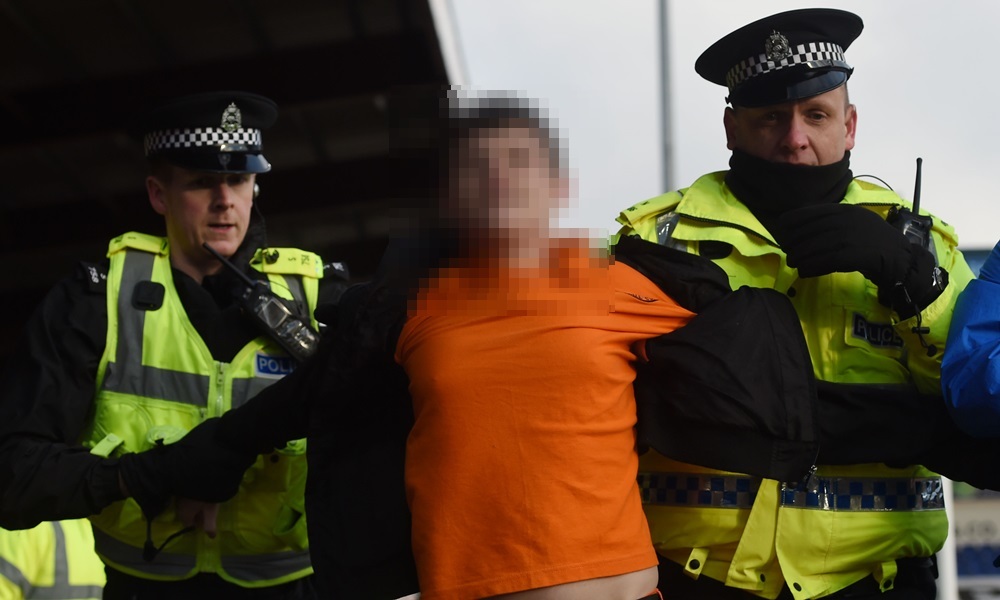There have been fresh calls for safe standing zones at premier league football grounds after Dundee United fans destroyed seats during Saturday’s clash with Ross County.
United’s Scottish Cup triumph ended in controversy after seven supporters were arrested following a pitch invasion and accusations of vandalism.
It is understood some supporters tore down signs inside the stadium and threw streamers and toilet rolls on to the pitch, with some spectators entering the field of play.
Ross County’s stadium manager, David O’Connor, said he was shocked by the damage and that he could not remember the last time such incidents unfolded in the Highlands.
He told The Courier he felt it was now time for the authorities to consider introducing safe standing areas within Scottish football grounds.
He said: “Some fan bases don’t want to sit down and start jumping up and down on their seats. It’s actually quite unsafe.”
Mr O’Connor continued: “I would have to say that I am surprised and disappointed.We have been left with more than 70 broken seats in the north stand.
“If that is the behaviour at football matches, the game and clubs need to look closely at it to stop it.
“Our ground staff will take the best part of a week to replace the seats.
“There’s graffiti sprayed on signs and annoying little stickers which have been left.It’s just something we are not used to in the north of Scotland.”
Match commander and superintendent Colin Gough said: “It is disappointing that a small minority of fans were involved within disorder in the ground.
“Disruptive behaviour will not be tolerated in any form. Inquiries are continuing and there is the potential for further arrests.”
Dundee United had appealed for fans to stay off the pitch, saying: “All fans are respectfully reminded to conduct themselves in a manner that does not bring the club and its support into disrepute and to adhere to the ground regulations and code of conduct of the Global Energy Stadium.
“All fans are advised to remain within the stand and to refrain from entering trackside or the field of play.”All-seater stadiums a response to tragedyAll-seater stadiums are a legacy of the Hillsborough disaster of 1989 in which 96 Liverpool fans died during the FA cup semi-final clash against Nottingham Forest in Sheffield.
Hundreds more were injured in the tragedy.
The official inquiry into Hillsborough blamed police for failing to properly control or redirect the crowd asthousands of fans, who had arrived late for the game because of traffic and rail delays, attempted to enter the stadium at the same point.
In a bid to prevent any repeat, the Taylor Reportrecommended all top-flight clubs in England and Scotland introduce all-seater stadiums by 1994-95.
Initially, the authorities demanded all stadiums inScotland’s top flight had a capacity of 10,000 but this was later reduced to 6,000.
Although many clubs including St Johnstone,which opened the all-seater McDiarmid Park four months after Hillsborough weremoving towards introducing all-seater stadiums beforethe tragedy, they are notuniversally popular.
Critics say the cost of making stadiums compliant withthe new rules damaged clubs financially while others claim the lack of terracing has harmed the atmosphere at games.
They also claim that when fans do stand up during a game it is more dangerous because it is easier to fall over the seats in front of them.
As a result, several clubs have campaigned for theintroduction of safe-seating areas, and it might not be long before standing areas are seen again in top-flight matches in Scotland.
Last summer Celtic won the right to install a rail seatingsystem at Parkhead that allows the seats to be locked in an upright position.
This will allow safe standing for 2,600 supporters during domestic league and cup matches.
Unlike in old terraces, each supporter has their owndesignated place to stand.
For European games,where all-seater stadiumsare required, the seats are unlocked.Clubs open to ideaSt Johnstone have previously commented on the issue and maintain anything that encourages bigger attendance will be considered.
Football administrator Paul Smith said: “We would look at any innovation that would seek to attract supporters back to Scottish football.
“There would be high costs to be considered. That is something which needs to be looked at.
“However, we would always be interested in anything that would keep people, or bring people back, to our game.”
Last February Dundee United chairman Stephen Thompson revealed he intended to spend £200,000 to enable the Tannadice club to become the first in the Premiership to reintroduce standing at games.
The club, however, later announced the plans had been put on the back burner.Comment: Safe would mean safeSafe standing at football grounds or at least the choice for clubs to have safe standing is a no-brainer, writes Courier sports editor Eric Nicolson.
Stadiums have got bigger and shinier over recent years but that hasn’t changed the enduring appeal of standing at a game of football.
Given the option, the vast majority of paying fans would rather be on their feet for 90 minutes than sitting down.
There would not bea return to the vast, crumbling, oftendangerous terraces of days gone by.
Modern technology has ensured that safe standing areas, where they have already been introduced in Europe, are just that safe.
